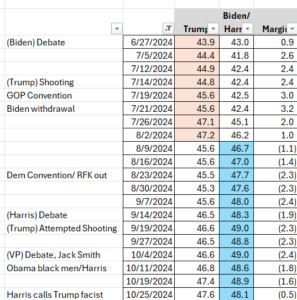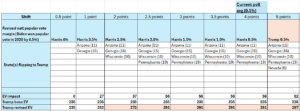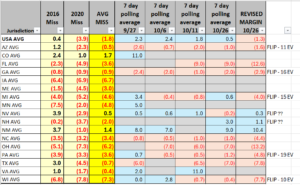Introduction
Early voting is past the midpoint in Louisiana (it concludes on Tuesday, 10/29), and Election Day is now in sight. Nationally, all but two possible states are undergoing in person voting, and the numbers are providing signals to us for party enthusiasm (or lack thereof).
Given that we’re in the closing days of the campaign, what has been going on (from a polling perspective) with the Presidential race?
Presidential Polling
When discussing polling for the 2024 Presidential contest, the main challenge for the party in power/Democratic nominee Kamala Harris is that the Biden Administration remains unpopular (42-56% approval/disapproval according to a 7-day average of polls taken, which is identical to 42-56% last week). Since Kamala Harris is Joe Biden’s Vice-President, that obvious association with an unpopular President remains a negative weight on her campaign. It also doesn’t help her campaign that voters are in a sour mood this year: they by a 64-28% margin believe our country is heading in the wrong direction.
What has been characteristic of this election cycle is that supposed “big events” generally haven’t moved the needle much. Even Special Counsel Jack Smith recent filing of a 165 page brief on Presidential immunity regarding former President Trump’s conduct on January 6 ironically may ironically have HELPED the Trump campaign narrow his poll gap: since his release of the brief, a Harris lead of 2.4% has steadily narrowed, and when you also have Vice President Harris’ attacking Trump as a fascist, her (7 day average) national poll lead has now narrowed down to 0.5% – to put her “lead” in proper perspective, RealClearPolitics notes that at this point in time, Biden in 2020 was ahead of Trump by 7.8%, while Hillary Clinton was up 5.4% over Trump in 2016.
Now that the race has narrowed in the closing days (when people are voting/at full attention), it’s possible that Donald Trump can win the national popular vote for the first time EVER for reasons that will be explained later in this article.
Below is a representation of the weekly changes in the national poll averages since the Trump/Biden debate:
National popular vote vs the Electoral College
When discussing the news value of “national popular vote polls”, it’s the Electoral College (and not the national popular vote) that actually elects a President, and that marginally benefits Republicans due to an inefficient vote distribution of Democratic and Republican votes across each state. In other words, a Republican can be elected President without attaining a popular vote majority (or even a plurality), because California and New York have in recent election cycles generated larger Democratic vote margins than Florida and Texas have for Republicans. And while large margins in California/New York “run up the (national popular vote) score”, “running up the score” doesn’t get a Democratic candidate any closer to the needed 270 electoral votes – winning critical swing states DOES.
To illustrate the disconnect between the Electoral College and the national popular vote, Joe Biden was elected in 2020 with a 4.5% popular vote margin (51.3-46.8%) over Donald Trump, but his victory was (using applicable 2024 numbers) a 303-235 Electoral College win (270 electoral votes are needed to win), Biden’s Electoral College victory was due to narrow victories in several states, like Arizona, Georgia, Michigan, Nevada, Pennsylvania, and Wisconsin.
Using that 4.5% national popular vote win as a baseline, we can assess the extent to which shifts in the national popular vote towards Trump could flip specific swing states, as national shifts have an impact in both swing and non-swing states. To be conservative in his analysis, JMC is assuming that only half of a national popular vote shift (percentage-wise) occurs in a swing state, since those states (which get an oversized amount of attention from either side) are less elastic in their movement towards a candidate.
Even with this conservative analysis, any movement towards Trump relative to a 4.5% national popular vote deficit would “flip” states to Trump that narrowly voted for Biden in 2020. For instance, Trump instantly flips Arizona and Georgia even if Kamala Harris wins the national popular vote by 3.5% (a shift of only 1% towards Trump, in other words), and those two flips alone get Trump up to 262 electoral votes – 8 electoral votes shy of a victory. A Harris win of 2.5% (a 2% shift towards Trump relative to 2020) would also flip Wisconsin and get Trump to the necessary 270 electoral votes.
Let’s apply that concept to current polling numbers – a current Harris lead of 0.5% translates to 291 electoral votes for Trump. In other words, a 0.5% Harris lead equals a 4.0% swing to Trump relative to his 2020 popular vote loss. A swing of that magnitude (even accounting for swing states’ inelasticity relative to the rest of the country) flips Arizona, Georgia, Pennsylvania, and Wisconsin and gives Trump the electoral votes he needs to win. Below is a representation of the electoral college impact of various national popular vote possibilities.
There is another aspect to polling that needs to be considered: the fact that previous election cycles (specifically, 2016 and 2020) had polling errors that materially understated Donald Trump’s support, particularly in the swing states that mattered. If we were to quantify the amount that the average of last week polls were “off”, and factor that error into the average of current polling over the last 7 days, what we find is that Trump can (based on current polling) flip Arizona, Georgia, Michigan, Pennsylvania, and Wisconsin. Assuming that polling accuracy has not improved since 2016/2020, those flips would get him (under this hypothetical example) 306 electoral votes. Furthermore, depending on partisan intensity, Nevada and/or New Hampshire could flip (thus increasing his electoral vote count to 316).
The early vote
While technically Election Day is November 5, an increasing number of voters are choosing to vote before that. Research done shows that 45% voted early in 2016, and that number surged to 69% in 2020. While the pandemic/mass adoption of mail voting certainly contributed to the increase in early voting in 2020, the reality is, Election Day voting is nevertheless becoming a thing of the past for an increasing number of people, which DOES impact the timing of when campaigns need to disseminate their messaging to voters.
This past week, early voting was in full acceleration mode: not only were ballots being returned from the 100% vote by mail states like California, Colorado, Hawaii, Oregon, and Utah; but in person early voting is underway in all possible states except for Oklahoma – its early voting starts on Wednesday, October 30. Of course, with Election Day in sight now, in person early voting will start to conclude, with Louisiana (on October 29) being the first state to end its in person early voting.
Early Voting Data
Currently, with data we have for mail ballot requests for all but three (Alabama, Tennessee, and Texas) states, 66.3 million (up from 62.6M a week ago) have already requested a mail in ballot. Furthermore, 38,560,003 in 48 states (no data readily available for Alabama and Missouri) have already voted either by mail or in person (compared to 13,260,650 a week ago). Early voting is expected to remain heavy for the next few days, then will level off as states gradually end their in person early voting.
There are several major themes coming from early voting this year (these themes directly impact the Presidential race):
- Mail in balloting is down 46%/at least 11.6 million voters compared to a similar point in time in 2020;
- The sharp decline in mail balloting is not being offset by an equal increase in in person early voting (as of last night, early voting is up 23%/at least 2 million voters);
- In multiple states that track the race of a voter (Georgia, Louisiana, and North Carolina), black voting intensity is noticeably less – to use one example, after 7 days of early voting in Louisiana, 24% of early voters were black, compared to 30% in 2020 (blacks make up 31% of registered voters in the state). A similar dynamic is happening in Georgia and North Carolina;
- Republicans are early voting more: at this point in time in 2020, the early vote was 48-30% Democratic; as of last night, the Democratic advantage has narrowed to 41-36%. Since early voting has long (easily for two decades) been a Democratic stronghold, this diminished Democratic enthusiasm has an electoral impact in several states. Put more plainly, it’s difficult to make up lost ground – like being behind by three touchdowns at halftime and hoping for a net four touchdown lead in the second half of the game.
Conclusion
Since the national popular vote is now moving towards a tie (perhaps even a lead for Donald Trump, when you factor in prior polling errors that understated the Trump vote in 2016 and 2020), that makes it that much more difficult for Vice-President Kamala Harris to amass 270 electoral votes.
In other words, while campaigns are still attempting to persuade voters, it’s purely an exercise of turning out the vote now.



